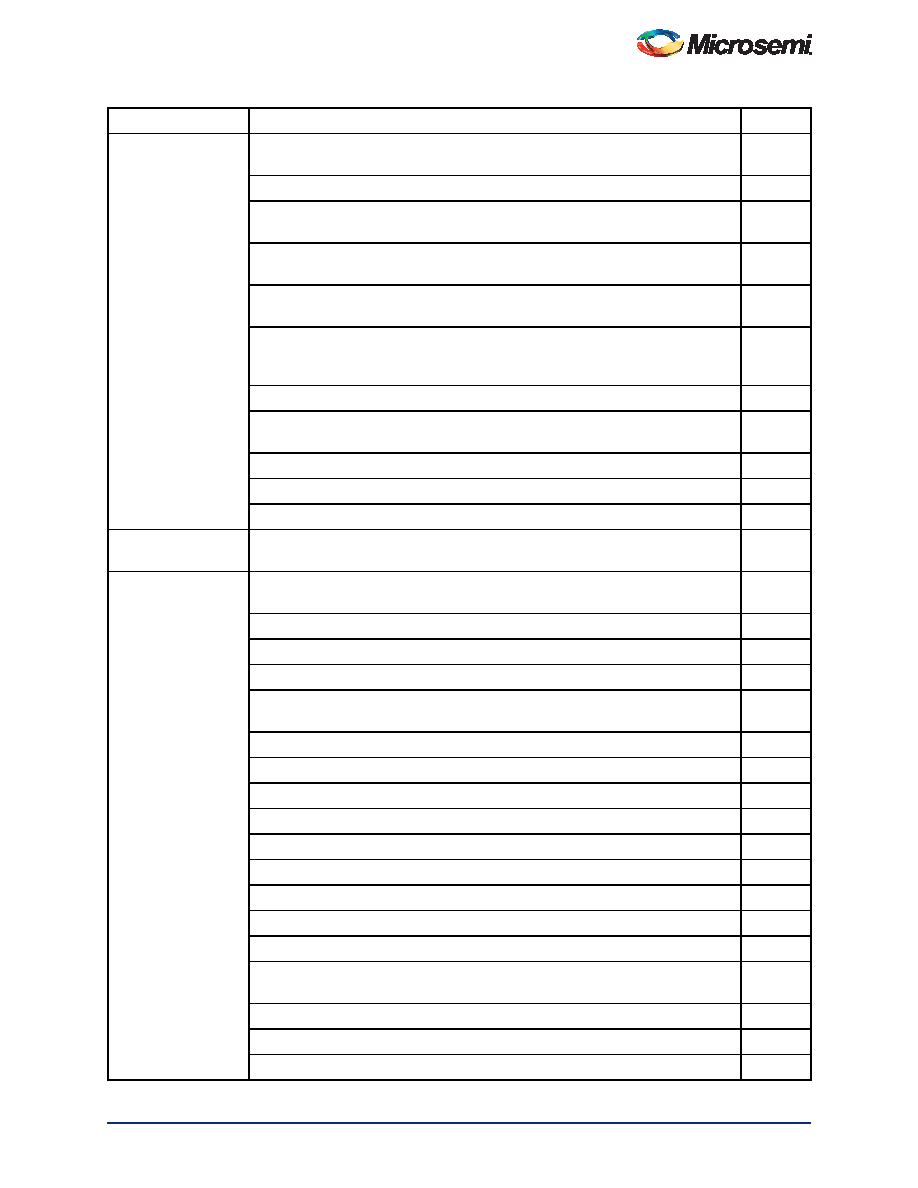- 您現(xiàn)在的位置:買賣IC網(wǎng) > PDF目錄4477 > A3PE600-2PQG208 (Microsemi SoC)IC FPGA 600000 GATES 208-PQFP PDF資料下載
參數(shù)資料
| 型號: | A3PE600-2PQG208 |
| 廠商: | Microsemi SoC |
| 文件頁數(shù): | 65/162頁 |
| 文件大小: | 0K |
| 描述: | IC FPGA 600000 GATES 208-PQFP |
| 標(biāo)準(zhǔn)包裝: | 24 |
| 系列: | ProASIC3E |
| RAM 位總計: | 110592 |
| 輸入/輸出數(shù): | 147 |
| 門數(shù): | 600000 |
| 電源電壓: | 1.425 V ~ 1.575 V |
| 安裝類型: | 表面貼裝 |
| 工作溫度: | 0°C ~ 70°C |
| 封裝/外殼: | 208-BFQFP |
| 供應(yīng)商設(shè)備封裝: | 208-PQFP(28x28) |
第1頁第2頁第3頁第4頁第5頁第6頁第7頁第8頁第9頁第10頁第11頁第12頁第13頁第14頁第15頁第16頁第17頁第18頁第19頁第20頁第21頁第22頁第23頁第24頁第25頁第26頁第27頁第28頁第29頁第30頁第31頁第32頁第33頁第34頁第35頁第36頁第37頁第38頁第39頁第40頁第41頁第42頁第43頁第44頁第45頁第46頁第47頁第48頁第49頁第50頁第51頁第52頁第53頁第54頁第55頁第56頁第57頁第58頁第59頁第60頁第61頁第62頁第63頁第64頁當(dāng)前第65頁第66頁第67頁第68頁第69頁第70頁第71頁第72頁第73頁第74頁第75頁第76頁第77頁第78頁第79頁第80頁第81頁第82頁第83頁第84頁第85頁第86頁第87頁第88頁第89頁第90頁第91頁第92頁第93頁第94頁第95頁第96頁第97頁第98頁第99頁第100頁第101頁第102頁第103頁第104頁第105頁第106頁第107頁第108頁第109頁第110頁第111頁第112頁第113頁第114頁第115頁第116頁第117頁第118頁第119頁第120頁第121頁第122頁第123頁第124頁第125頁第126頁第127頁第128頁第129頁第130頁第131頁第132頁第133頁第134頁第135頁第136頁第137頁第138頁第139頁第140頁第141頁第142頁第143頁第144頁第145頁第146頁第147頁第148頁第149頁第150頁第151頁第152頁第153頁第154頁第155頁第156頁第157頁第158頁第159頁第160頁第161頁第162頁

ProASIC3E Flash Family FPGAs
Revision 13
5-7
v2.0
(continued)
Table 3-6 Temperature and Voltage Derating Factors for Timing Delays was
updated.
3-5
Table 3-5 Package Thermal Resistivities was updated.
3-5
Table 3-10 Different Components Contributing to the Dynamic Power
Consumption in ProASIC3E Devices was updated.
3-8
tWRO and tCCKH were added to Table 3-94 RAM4K9 and Table
3-95 RAM512X18.
3-74 to
3-74
The note in Table 3-24 I/O Input Rise Time, Fall Time, and Related I/O
Reliability was updated.
3-23
Figure 3-43 Write Access After Write onto Same Address, Figure 3-44 Read
Access After Write onto Same Address, and Figure 3-45 Write Access After
Read onto Same Address are new.
3-71 to 3-
73
Figure 3-53 Timing Diagram was updated.
3-80
Notes were added to the package diagrams identifying if they were top or bottom
view.
N/A
The A3PE1500 "208-Pin PQFP" table is new.
4-4
The A3PE1500 "484-Pin FBGA" table is new.
4-18
The A3PE1500 "A3PE1500 Function" table is new.
4-24
Advance v0.6
(January 2007)
In the "Packaging Tables" table, the number of I/Os for the A3PE1500 was
changed for the FG484 and FG676 packages.
ii
Advance v0.5
(April 2006)
B-LVDS and M-LDVS are new I/O standards added to the datasheet.
N/A
The term flow-through was changed to pass-through.
N/A
Figure 2-8 Very-Long-Line Resources was updated.
2-8
The footnotes in Figure 2-27 CCC/PLL Macro were updated.
2-28
The Delay Increments in the Programmable Delay Blocks specification in Figure
2-24 ProASIC3E CCC Options.
2-24
The "SRAM and FIFO" section was updated.
2-21
The "RESET" section was updated.
2-25
The "WCLK and RCLK" section was updated.
2-25
The "RESET" section was updated.
2-25
The "RESET" section was updated.
2-27
B-LVDS and M-LDVS are new I/O standards added to the datasheet.
N/A
The term flow-through was changed to pass-through.
N/A
Figure 2-8 Very-Long-Line Resources was updated.
2-8
The footnotes in Figure 2-27 CCC/PLL Macro were updated.
2-28
The Delay Increments in the Programmable Delay Blocks specification in Figure
2-24 ProASIC3E CCC Options.
2-24
The "SRAM and FIFO" section was updated.
2-21
The "RESET" section was updated.
2-25
The "WCLK and RCLK" section was updated.
2-25
Revision
Changes
Page
相關(guān)PDF資料 |
PDF描述 |
|---|---|
| A3PE600-2PQ208 | IC FPGA 600000 GATES 208-PQFP |
| GBB106DHAS-S621 | CONN EDGECARD 212PS R/A .050 SLD |
| A3P1000-1FG484 | IC FPGA 1KB FLASH 1M 484-FBGA |
| EPF10K10ATC144-1N | IC FLEX 10KA FPGA 10K 144-TQFP |
| AMM22DRMI-S288 | CONN EDGECARD 44POS .156 EXTEND |
相關(guān)代理商/技術(shù)參數(shù) |
參數(shù)描述 |
|---|---|
| A3PE600-2PQG208I | 功能描述:IC FPGA 600000 GATES 208-PQFP RoHS:是 類別:集成電路 (IC) >> 嵌入式 - FPGA(現(xiàn)場可編程門陣列) 系列:ProASIC3E 標(biāo)準(zhǔn)包裝:40 系列:SX-A LAB/CLB數(shù):6036 邏輯元件/單元數(shù):- RAM 位總計:- 輸入/輸出數(shù):360 門數(shù):108000 電源電壓:2.25 V ~ 5.25 V 安裝類型:表面貼裝 工作溫度:0°C ~ 70°C 封裝/外殼:484-BGA 供應(yīng)商設(shè)備封裝:484-FPBGA(27X27) |
| A3PE600-2PQG896 | 制造商:ACTEL 制造商全稱:Actel Corporation 功能描述:ProASIC3E Flash Family FPGAs |
| A3PE600-2PQG896ES | 制造商:ACTEL 制造商全稱:Actel Corporation 功能描述:ProASIC3E Flash Family FPGAs |
| A3PE600-2PQG896I | 制造商:ACTEL 制造商全稱:Actel Corporation 功能描述:ProASIC3E Flash Family FPGAs |
| A3PE600-2PQG896PP | 制造商:ACTEL 制造商全稱:Actel Corporation 功能描述:ProASIC3E Flash Family FPGAs |
發(fā)布緊急采購,3分鐘左右您將得到回復(fù)。